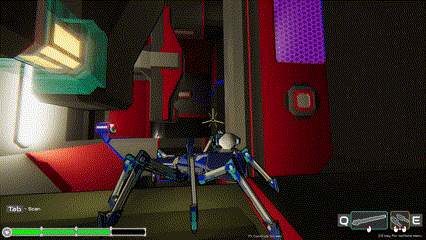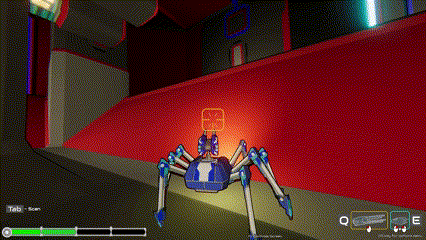
Developer: Champlain College Game Studio
Platform: PC
Engine: Unity
Role: Lead Game Design, Gameplay Programming







Arachnotron is a third person action shooter where the player can traverse every surface of the environment to their advantage. As a mechanical spider-tank hellbent on revenge, use the different weapons at your disposal to take down the criminal organization S.W.A.R.M.
My Work
Arachnotron was the final student project I participated in, and was a really interesting design and tech challenge throughout. Starting out as a team of 4 in 1st semester pre-production, we wanted to create a third-person-shooter where the player could smoothly traverse any surface. When that was successful, we expanded to a 12-person team and built 3 different levels and boss fights over the course of the 2nd semester. I was design lead throughout the project, and did a lot of the technical gameplay work, as well as some procedural animation.
Wall-Climbing Movement
The tech for the wall-climbing movement actually originated in another project I worked on for Global Game Jam 2018. In that project, I had built a simple system that would move the mars rover smoothly over rough terrain. So when my team and I later that year decided to make a game about a mechanical spider-tank, I decided to re-purpose that to handle even more different types of terrain.
We found that many players who weren’t accustomed to first/third person shooter gameplay were disoriented by the wall-climbing. To some extent this was just the nature of the game we were making, but I spent the whole project trying to find ways to minimize that confusion wherever we could. In the end, it was mainly lots of time spent polishing the movement & camera smoothing, and some options for the player to adjust to help reduce any jarring camera transitions. This informed the level design as well, as different shapes of terrain could cause more trouble than others.
Procedural Animation
Getting the legs of the spider-tank to crawl across any terrain was another core challenge on this project. I had already designed the movement logic with this in mind, with the ground-detection playing double duty as the positioning for the feet of the tank as well. Our lead programmer built a system for inverse kinematics that I took to make a system for placing and moving the feet as the rig moved around the game-world.
Combat Mechanics and UI
The limited firing angles of the weapons were an important part of adapting the combat mechanics for so much three-dimensional movement. I made sure to balance them to be restricted enough to get the player to think about their approach in the space, while keeping the restriction from becoming frustrating.

The Repeater Turret serves as the player's main weapon, being both easy to use and strong in most cases

The Fang Cannon's long range and lower angle make it strong when used while climbing around edges

The Railgun kills almost anything in one shot, but its tight angle and charge time requires careful positioning
The Tesla Coil is mostly used to power switches in the environment, but it does very high damage at point-blank range

We managed to create a boss encounter at the end of each of the 3 levels. The focus of these was to emphasize the wall-climbing and 3D navigation, so we approached them like small, more mobile versions of the same kinds of level design seen in the lead-up to each one.
[video of 1st boss fight]
Level Navigation and Readability
One of the biggest challenges of this project was making the level design readable, and navigation easy enough for players to understand. Being able to climb on any surface made it very easy to get turned around, so we had to simplify our approach to the level design a few times as we experimented. Eventually, we gave each room color-coded walls to show up/down more clearly. Each enemy and any object relevant to progression through the level are also highlighted in the scan view, even through walls. These measures helped a lot but I think this was still the weakest point of the design, players would still get turned around in simple rooms. If we were to do it again, I think using varied shape language in different parts of each room would be important for making navigation more straightforward, as that’s what set apart the more well-designed areas we had.
Working with two other level designers on this project was an interesting challenge to solve. The levels were three-dimensional enough that any two-dimensional level design document would be insufficient to communicate the design, and we weren’t fast enough with 3D blockouts for that to be useful in the very early stages of level design. Fortunately, during development we had easy access to a VR headset and a 3D VR drawing program! Being able to sketch out our level designs very quickly in full-3D made the process go much more smoothly.